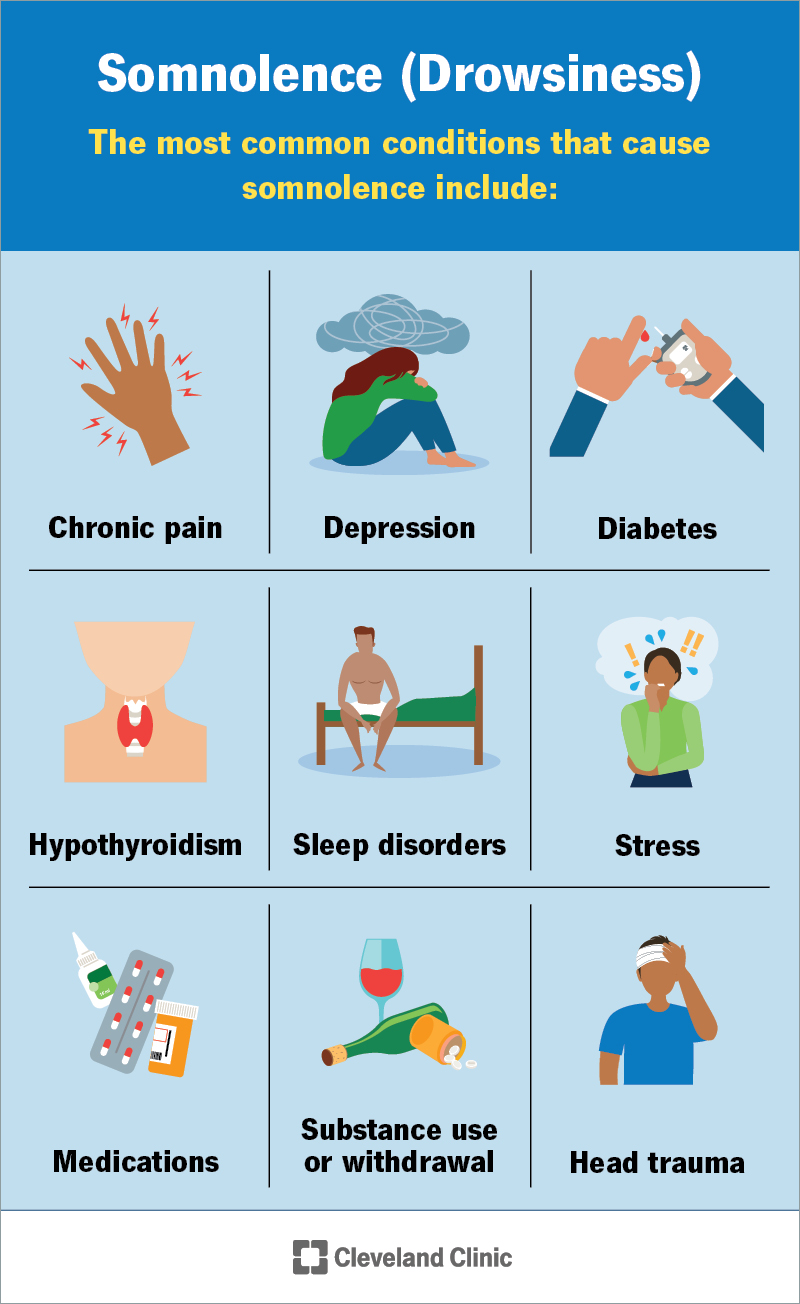Somnolence, also known as drowsiness or excessive sleepiness, is wanting to fall asleep. You usually notice this right before bedtime. But somnolence can also interfere with your daytime activities. It can happen with several underlying conditions and as a side effect of several types of medications. Treatment options are available.
Advertisement
Cleveland Clinic is a non-profit academic medical center. Advertising on our site helps support our mission. We do not endorse non-Cleveland Clinic products or services. Policy
Somnolence, also known as drowsiness, is feeling tired and wanting to fall asleep. This symptom may make you nod off when you don’t want to, like when you’re reading the newspaper or when you should be paying attention (like during a lecture or meeting).
Advertisement
Cleveland Clinic is a non-profit academic medical center. Advertising on our site helps support our mission. We do not endorse non-Cleveland Clinic products or services. Policy
It’s usually a symptom you notice before going to bed. But excessive daytime sleepiness may be a symptom of an underlying medical condition or a side effect of a medication. It might also lead to dangerous outcomes if you drive or do certain tasks while drowsy.
A healthcare provider can help you determine what’s preventing you from staying awake during the daytime and offer treatment options so you can feel better.
If you have somnolence, you may feel like you:
Two common types of somnolence are:

There are several possible causes of somnolence. One of the most common harmless causes is boredom or having a lack of interest in what’s going on around you.
Advertisement
Sometimes, an underlying condition may be the reason for this symptom. Common conditions that cause drowsiness include, but aren’t limited to, the following:
Somnolence may be a side effect of taking certain medications. Some of the most common medications that cause drowsiness include:
Substances that contribute to substance use disorder like alcohol and opioids (narcotics), among others, may also affect your ability to feel awake.
If you have occasional somnolence, especially before bedtime, it’s natural to fall asleep to treat this symptom. You should feel refreshed when you wake up.
If somnolence persists during the daytime, you should talk to a healthcare provider. They’ll run diagnostic tests to see what’s causing this symptom. They’ll also take a look at what medications you currently take to see if this symptom is a side effect.
Treatment varies from person to person. If a medication side effect is the culprit, your provider will adjust the dosage or type of medication you take. Don’t change how you take medications unless your provider approves it. Your provider will help you manage any underlying conditions if necessary.
Daytime drowsiness usually happens at unwanted times. You might fall asleep while someone is talking to you or during a movie or meeting, or you may not feel awake enough to participate in your favorite activities. It can interfere with your ability to complete your school or work responsibilities or meet social or relationship commitments.
It can also be dangerous. For example, you may fall asleep while driving. If you experience somnolence, you shouldn’t perform tasks that require your full attention, like operating heavy machinery.
To prevent these complications, check with your healthcare provider before starting a new medication to learn more about the side effects. If you feel tired, ask someone else to drive you so you can safely get to where you need to go.
Not all cases can be prevented, especially if an underlying condition causes it. But you can reduce your risk by:
Advertisement
Talk to a healthcare provider if:
As your body winds down after a long day, it’s normal to feel like you need to sleep before bedtime. But if you feel drowsy often during the daytime, it’s time to talk with a healthcare provider.
There are a lot of possible causes for somnolence, so you’ll need to visit a provider for a check-up and possible testing to figure out what the cause might be. Treatment options are available, so you don’t have to miss out on your favorite activities because of this symptom.
Advertisement
Hypersomnia disorders cause you to be sleepy all day long. And can get in the way of life. Cleveland Clinic’s sleep experts are here to help.

Last reviewed on 01/29/2025.
Learn more about the Health Library and our editorial process.